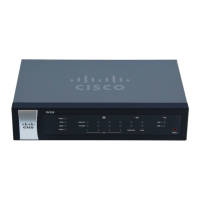Setup
Inbound Load Balance
Cisco RV320/RV325 Administration Guide 43
3
To delete an entry from the list, click the entry that you want to delete, and then
click Delete.
To view current data, click View Routing Table. The Routing Table Entry List
appears. You can click Refresh to update the data, or click Close to close the
pop-up window.
Inbound Load Balance
Inbound load balancing distributes inbound traffic equally to every WAN port to
make best use of bandwidth. It also can prevent traffic from unequal distribution
and congestion.
To enable and configure inbound load balancing:
STEP 1 Click Enable Inbound Load Balance.
STEP 2 Enter the Domain Name information:
• Domain Name—DNS service provider-assigned domain name.
• TTL (Time-to-Live)—Time interval for DNS inquiries (second, 0~65535). A
long interval affects refresh time. A shorter interval increase the system load,
but the accuracy of the Inbound Load Balance is better. You can adjust this
parameter for the best performance for your network.
• Admin—Administrator E-mail address.
STEP 3 Enter the DNS Server parameters:
• Name Server—DNS server that translates the domain name.
• Interface—WAN interface corresponding to the name server. The system
shows the acquired, enabled WAN IP addresses.
STEP 4 Enter the hostname that provides services, such as the mail server or FTP server
in the Host (Record) Name field and select the WAN IP interface to where inbound
traffic is distributed.
STEP 5 Enter the Alias that assigns several names to one computer host that might
provide several services and the Target, an existing A Record domain name.

